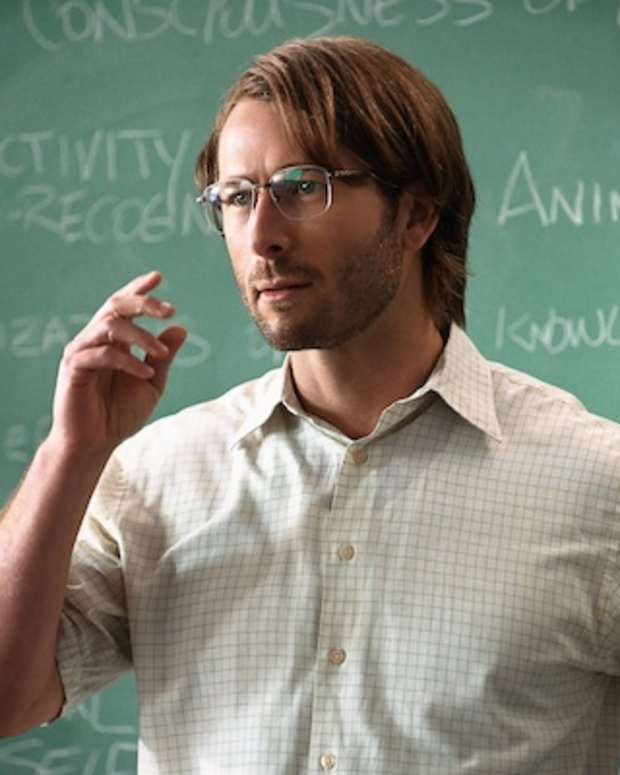Adapting 'A Beautiful Mind': Screenwriter Akiva Goldsman
“I got a 410 on my math SATs. You get 200 automatically for just writing your name correctly. And, there I was, writing a screenplay about a mathematical genius.”
Such was the challenge set before Akiva Goldsman, screenwriter of the adaptation of A Beautiful Mind, the biography of genius mathematician and physicist, John Forbes Nash, Jr. (originally authored by Sylvia Nasar, economist and journalist, for Touchstone Books).

Russell Crowe stars as John Nash in A Beautiful Mind. All pictures courtesy of Eli Reed. 2001 Universal Studios. All rights reserved
Nash suffered from paranoid schizophrenia and despite his spectacular intellectual powers, the mental illness nearly destroyed his life. Nash experienced the heights of scientific notoriety and the depths of insanity. He made an astonishing discovery early in his career and stood on the brink of international acclaim. Handsome and witty to the point of arrogance, Nash seemed destined to that sort of intellectual stardom reserved for famous literary figures and artists.
However, Nash soon found himself on a painful and harrowing journey of self discovery that took him to the brink of absolute madness. After many years of struggle, he eventually triumphed over his tragedy and received the Nobel Prize late in his life.
Russell Crowe, 2001’s Best Actor Academy Award-winner for his role of Maximus in Gladiator, puts down his sword and shield for a piece of chalk in this follow-up project. Director Ron Howard (Apollo 13, Splash, The Grinch Who Stole Christmas) compiled a powerhouse cast to join Crowe, including Ed Harris (Crowe’s co-nominee for Best Actor for his lead turn in last year’s Pollock) and Jennifer Connelly (Harris’ Pollock co-star) as Nash’s wife, Alicia. Judd Hirsch, Christopher Plummer, and, of course, Clint Howard round out the cast.
Goldsman, one of the hotter assignment writers in Hollywood at the time, came off the screenplays Practical Magic (with Sandra Bullock and Nicole Kidman), Lost in Space and Batman & Robin en route to the Nash biography. He came to the industry in 1994 with Silent Fall before moving on to the adaptation of John Grisham’s The Client (with Tommy Lee Jones and Susan Sarandon) and another Grisham project, A Time to Kill (with Samuel L. Jackson, Matthew McConaughey, Kevin Spacey, and Sandra Bullock).
“I was a totally failed fiction writer,” Goldsman said. “I literally never sold a thing, and I have shoeboxes full of rejection letters—including a very nice one from the New Yorker. I did sell my first screenplay, but that was hardly the first thing I wrote.
“I was never the best writer in any of my classes, but I’m the only one who kept writing. So, it comes down to persistence and practice instead of just pure talent. Perhaps in dialogue some talent helps because you need to have an ear and be able to pick up how people speak. But, short of that ability, all screenwriting is learnable. You get better as you write, and just as the first sit-up isn’t easy, neither is the first screenplay, short story or novel.”
He added, “Unless, you’re fated for bad luck in life, your good luck will come along. So, it’s a matter of continuing to write and improving your skills while you wait for that luck to arrive.
“You never get fired from being a writer, but you can fire yourself. You need genuine stubbornness and the neurotic need for someone to like something you’ve created.”
When it comes to something Goldsman created, the motion picture version of A Beautiful Mind is a presentation of Nash’s life with a focus on his struggles as a human being and his endearing relationship with his loving wife.
The best-selling biography by Nasar originally appeared in excerpt form in Vanity Fair Magazine. The article generated significant buzz, and Hollywood screenwriters and producers clamored for a chance to read the story in its entirety. So, Touchstone, the book’s publisher, released the manuscript in pre-published form to Hollywood heavyweights.
“I actually read the book in galley form long before it came to the bookstores,” Goldsman said. “I loved the book and felt that I just had to be the one to write the screenplay. It truly had an effect on me.
“I actually may have begged for the job. I knelt on the floor of his office and pleaded for hours until he gave me the assignment.”
According to Princeton University legend, Nash was known as “The Purple Phantom”—a figure many students saw shuffling around the corridors of the math and physics building wearing purple sneakers and writing numerology treatises on the blackboards. That tragic figure was Nash lost in the depths of his illness. The university allowed the suffering man to remain on the grounds even during his darkest days. In fact, Nash wandered around those hallowed halls for almost 30 years.
When the Nobel Prize committee began debating a prize for game theory, Nash’s name inevitably came up; but the committee quickly dismissed it. However, in 1994, Nash was well in remission from schizophrenia and shared the Nobel Prize in Economics for work done some 45 years previously. Nasar follows Nash from his birth in a small, poverty-stricken West Virginia town, to his current state of tentatively sane, semi-retirement that he shares with his ex-wife, Alicia.
Ironically in most of Nasar’s narrative, Nash often seems more likeable and in touch with his humanity when suffering from his illness. When healthy and at the top of his mental game, Nash seems arrogant, abusive, and insensitive. Stripped of his staggering mental powers, he gains humility and changes his view of the people around him.
Goldsman needed to make an often unsavory protagonist and make him more sympathetic to a mass audience.
After prying the prized gig away from the legions of writers knocking on Grazer’s and Howard’s door, Goldsman settled into what he calls his “mediumspeed” writing process.
“I’m not necessarily slow or fast when it comes to writing,” he said. “I usually write in two phases—outline and first draft.
“The outline phase is interminable but essential. Since this is a story about a mathematician, perhaps this is as close to math as the writing process comes. You must work your way through the mechanics and break the back of the story before you can proceed to putting words on paper. All the great dialogue in the world won’t save you if the story structure isn’t there.”
Once through the long outlining process, Goldsman “barrels through the first draft straight through from start to finish.” The entire process took four months from commencement of the first draft through completion of his first submitted draft.
During that first draft, Goldsman confronted the curse of motion picture adaptation—literary snob appeal. No matter how successful the screenplay and film, there will always be the crowd that chimes in with, “Well, it’s not as good as the book.” The same attitude applies to stage plays and even graphic novels. Even smash hits like Jaws, Silence of the Lambs, or Amadeus had to overcome this age-old criticism.
True to form, some critics leveled attacks at the work of Howard and Goldsman as ranging too far afield into fiction in this cinematic recreation.
“I did not set out to recreate the book or tell the same story,” Goldsman said. “This film is an attempt to present a recreation and interpretation of Nash’s life.”
Goldsman’s mother was a prominent East Coast child psychologist, and his parents opened one of the first group homes for children suffering from what was then diagnosed as infantile autism or child schizophrenia. So, Goldsman seemed a natural to tackle this look at Nash’s experience.
“I grew up with my parents in that group home environment, so that’s where I first encountered the mindset involved in this story. That was one of the reasons I was really drawn to Nash’s story and wanted to be involved with this project.”
As usually happens with book to film transformations, some elements of the book fell away in favor of some creative license. Goldsman and Howard added an espionage element as government forces try to make official use of Nash’s genius despite his delicate mental state. Also, the book included some unsavory, gritty insights into Nash’s sexual problems, marital difficulties, affairs, mentally ill children, and other personal issues that led to Nash’s psychological collapse.
“This was not conceived as a true biopic,” Goldsman said. “I set out to reconstruct the spirit and experience of the man. I was inspired by the architecture of Nash’s life—the contrasts from genius to madness and the bond with his wife that guided him through that journey.”
Goldsman added, “That difficult relationship with his dedicated wife is the true constant in Nash’s life as he struggles through his mental illness.”

Russell Crowe stars as John Nash in A Beautiful Mind. All pictures courtesy of Eli Reed. ©2001 Universal Studios. All rights reserved
Obviously a 100 to 120-page screenplay lacks the space to embrace as much detail and information as a 300-page biography, so Goldsman included the spirit of Nash’s experience without the exhaustive insight of the book. For example, author Nasar spends many pages discussing the symptoms and treatment of schizophrenia —exposition that would absolutely stymie any effective screenplay.
Also, Goldsman had to interpret Nash’s Nobel Prize-winning feats for a mass audience without regard to any viewer’s potential knowledge of math or physics.
The Nash Equilibrium is the mathematician’s most significant and famous discovery. The theory states that, in noncooperative, competitive games with perfect information (when all possibilities are in principle knowable, even if not in practice known to all competitors), there exists the best strategy leading to a predetermined outcome. This is why games such as checkers or chess are in principle solvable. The outcome is determined even before the players make any moves. The reason these games remain interesting is that players do not know the most rational strategy and thus make “mistakes,” leading to outcomes that are for practical purposes not exactly predictable.
When theorists apply this game strategy to other fields, it has significant impact in economics, intelligence, etc.
That is a lot for a screenwriter to squeeze down into a script’s limited exposition quotient, but Goldsman found a simple, if self-deprecating method.
“I tried to explain it to someone as dumb as me,” he said. “I figured if someone with my ability for math could embrace my explanation, anyone in the audience could.”
After tackling the first draft challenges and submitting that initial effort to Grazer and Howard, Goldsman set out on the extensive, seemingly never-ending revision process.
“Revision was constant,” Goldsman explained. “Ron looked at the first draft, and we explored different possibilities. Then, I set to work on a second draft based upon those notes.”
By this point, Crowe took on the role of Nash. That second draft went to Crowe who approved of the projects status. Fortunately, Goldsman didn’t need to consider the pressure of writing for a recent Oscar winner.
“There was no cast originally, so my job was to portray a man—not write a role for Russell Crowe,” Goldsman said. “However, I was thrilled when Russell came on board. He’s not only very talented, but he is an actual genius. You see that working in this film—a genius portraying a genius.
"In addition to his obvious acting talent,Russell also brings an outstanding story sense and he contributes that to the production on-set. He had a profound impact on the film’s narrative.”
Goldsman also had nothing but praise for director Howard whom he described as “not only a gifted director, but also the nicest guy on the planet.
“He seems almost impossibly nice,” Goldsman joked. “He is literally and wildly inclusive. I was on the set every moment of production, and Ron would consistently consult with and include me in the creative process with Russell.”
The positive creative environment and generous revision process allowed Goldsman to come to grips with the daunting creative task of portraying an genius mind.
“I don’t feel that I really needed to recreate Nash’s genius,” Goldsman said. “In reality, Russell had to do it. To me, the whole point of the story is that the human mind, is the human mind, without regard to whether the person in question is a genius. What a genius goes through in his or her life, day after day, is essentially no different from what you or I do to get through the day. Ironically, we feel alienated by the insane and the genius alike.”
“Honestly, there are better movies about genius and the workings of the human mind out there. This is a story about a man, John Nash, and his wife, a woman who was essential to his development and survival.
“I wanted to make the genius human,”Goldsman added. “In this story, what shines through in Nash is his humanity throughout his struggle."
John Scott Lewinski's feature script 'Slabtown' was the featured work at the Cinestory Script Session Awards. 'Slabtown' has now been adapted into a stage play set for production in regional theaters. His feature script, 'Darwin's Game', won entry into the Telluride Independent Film Festival. 'Forced Perspective' won the Wisconsin State Film Commission award for “Best Screenplay Set in the State.” More informaion on Lewinski can be found on his website.
Related Articles:
- Balls of Steel: Adapting Your Script Into a Novel
- 'Carnage': An Interview with Yasmina Reza
- Podcast: Writer-Director Tate Taylor on 'The Help'





![[L-R] Omar J. Doresy and Sebastian Maniscalco in Bookie (2023).](https://scriptmag.com/.image/ar_8:10%2Cc_fill%2Ccs_srgb%2Cfl_progressive%2Cg_faces:center%2Cq_auto:good%2Cw_620/MjA2NjY1MDM3NzA2Njk5OTgw/omar-j-john-johnsonmax.jpg)





